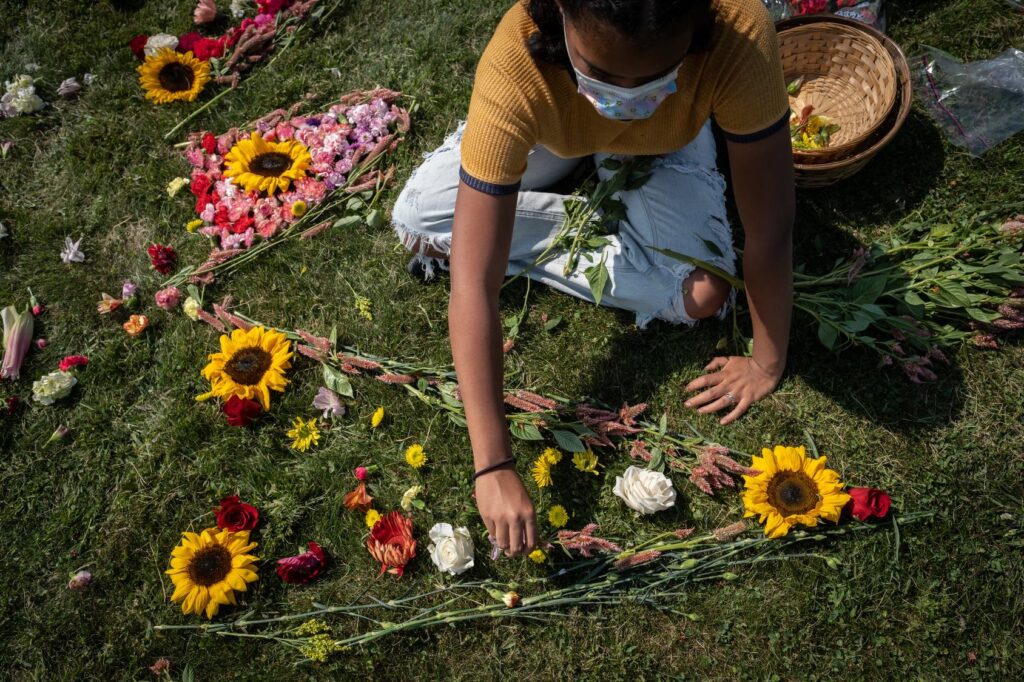For the past five years, usually some time in August, members of the Flower Power Collective can be seen hauling buckets of flowers to the Indian Mounds Park in St. Paul.
From sunrise to sundown, artists and community members carefully place flower after flower on the grass, working to create a vibrant art piece. Group members say their goal is to provide healing spaces for those who have been impacted by their criminal justice system.
Whether they were incarcerated or knew someone who was, community members are encouraged to bring bouquets and share stories.
“It just comes together in such a beautiful way. Like, there’s just enough structure where we can still flow like water. That’s that’s the only way I can describe it,” said artist Bella Dawson, who joined the group in high school.
Laura LeBlanc, who helped found the Flower Power collective, said it was born during protests after the police shooting of Jamar Clark – particularly because she wasn’t there.
“And I asked myself why I wasn’t at the protests, because I believe in the protest deeply,” said LeBlanc, who formerly worked as an advocate for youth in the criminal justice system.
Though she still doesn’t have an answer, “what was clear to me was, we needed other spaces besides protests. We needed spaces where we build the world that we want to live in, that we’re honoring the tragedy and not ignoring it. So that’s what Flower Power is, is honoring the tragedy of that full continuum of the criminal justice complex.”
The first flower display LeBlanc remembers doing was at Philando Castile’s funeral. LeBlanc said the group started working at 4:30 in the morning at the cathedral grounds, to avoid getting removed before their piece was finished.
But they didn’t get kicked out. Now, the group has a regular relationship with Philando’s mother Valerie Castile, and creates flower arrangements for the yearly candlelight vigil she hosts for her son.
Many of the Flower Power artists bring a passion for advocacy and social justice, said LeBlanc. And for Dawson, the young artist, Flower Power provides a new kind of way to protest – one that doesn’t necessarily mean taking to the streets.
“At the end of the day, if you’re not right within here, within your heart, it’s like, how are you showing up in the community?” asked Dawson. “We don’t want a space like Flower Power to just be on that day. We want to be able to create spaces like this, where people can flow like water, and breathe and love and connect.”
Fellow artist and roommate Sabrina Nur said that’s exactly what Flower Power was able to do last summer at George Floyd Square: provide a space for people to breathe.
“Because people are chanting, “I can’t breathe” and like you’re putting that into the universe, you know, so it’s affecting you. People don’t realize the words they say and the actions they do, how that affects you,” Nur said. “So we need spaces like Flower Power where we can breathe, we will breathe, we have the right to breathe.”

The Flower Power collective is housed within the nonprofit Oyate Hotanin, which focuses on uplifting American Indian art and activism. The artists gather at the Indian Mounds Park due to their long fight to keep the area preserved and respected as a burial ground, said executive director Strong Buffalo.
The grounds were where Dakota people used to bury their dead, along with their belongings. Today, only six of the dozens of the original burial mounds are still standing, as the others were destroyed by farming, housing and park development.
“It was almost like our ancestors were imprisoned, too,” said Strong Buffalo. “Those Indian mounds have been burials for Indian people for probably about 10,000 years and has been inside of this city park in St. Paul for about 160 years without people really realizing that these are the remains of people.”
The Flower Power Collective’s next event at Mounds Park takes place on August 7 from sunrise to sundown.

